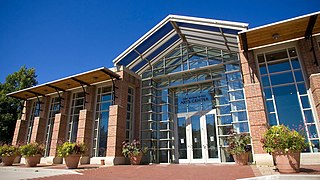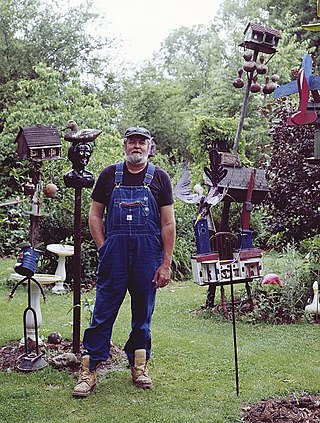Related Research Articles

The John Michael Kohler Arts Center is an independent, not-for-profit contemporary art museum and performing arts complex located in Sheboygan, Wisconsin, United States. The center preserves and exhibits artist-built environments and contemporary art. In 2021, the center opened the Art Preserve, a satellite museum space dedicated to art environments.
Rodney Hardee is a folk artist who resides in Lakeland, FL. He is a working-class, self-taught, religiously inspired southern artist. He has been painting folk art since 1972 and has quite a unique style of art. It is folky but has an elegant touch with fine-grained images, and is often religious bordering on slightly odd.

African American Museum of Dallas is an American art museum located at 3536 Grand Avenue in Fair Park, Dallas, Texas. The museum was founded in 1974 and has operated independently since 1979. The 7 million dollar structure which is now its home, was funded through private donations, and a 1985 Dallas city bond election, which provided 1.2 million towards its construction. The 38,000-square-foot (3,500 m2) structure, built in the shape of a cross, is made of ivory-colored stone. Natural materials and design motifs are used throughout the museum in a manner reminiscent of pre-industrialized cultures of the African continent.
Esther Hamerman was a Polish-born American painter. Hamerman, who was self-taught, has been described as a "leading practitioner" of memory painting. She is considered a folk artist.

Hawkins Bolden (1914–2005) was an American artist known for his "scarecrow" assemblages made from pots, pans, leather belts, rubber hoses and other found materials.
Tella Kitchen was an American folk artist known for her paintings of landscapes and town life in rural Indiana and Ohio. She was a self-taught artist, whose work was based on her memories of her life. Her work achieved national recognition, and can be found in the collections of the American Folk Art Museum.
The Folk Art Society of America is a 501(c)(3) organization, founded in 1987 "to advocate the discovery, study, documentation, preservation and exhibition of folk art, folk artists and folk art environments, with an emphasis on the contemporary". The society publishes a journal, the Folk Art Messenger three times a year, and holds an annual conference that includes a symposium with speakers as well as visits to folk art museums and private art collections. Members of the organization include artists, collectors, academics, and curators, as well as libraries and other arts organizations.

George Paul Kornegay was an American folk and outsider artist, and minister in the African Methodist Episcopal Zion Church, who created a large Christian visionary environment with found objects near Brent, Alabama.
Georgia Blizzard was an American ceramic artist from Virginia. She was self-taught and her work is in the permanent collections of several American art museums.
Caroline Goe was a self-taught New York artist.

Binford Taylor Carter, Jr., known as Benny Carter or Bennie Carter, was an American contemporary visual artist. His primary focus was as a painter and sculptor within the genres of folk art and outsider art.
Arthur Dial was an American painter and sculptor who lived and worked in Bessemer, Alabama. He was a part of the Dial family of artists, which includes his older brother, Thornton Dial, and his nephews, Thornton Dial Jr., Richard Dial, and Ronald Lockett.

The Old Trapper's Lodge is a California Folk Art display started in 1951 in the United States. It was designated a California Historical Landmark on March 25, 1985. The Old Trapper's Lodge art work is located in Los Angeles Pierce College's Cleveland Park at 6201 Winnetka Avenue in Woodland Hills, Los Angeles in Los Angeles County. The folk art is a life-size sculpture made by John Ehn (1897-1981), a self-taught artist who loved Old West culture. Ehn used his family as models and turned them into life-size outsider art Old West characters.

Dilmus Hall (1896–1987) was a modern African American sculptor from Athens, Georgia.
Brooks Yeomans is an American artist often classified as an outsider artist.
Mercedes Jamison (1933–1997) was an American artist based in Queens, New York known especially for the paintings of fragmented faces and landscapes she created while affiliated with HAI.
Charles Gillam Sr. is a self-taught woodcarver and mixed-media artist from New Orleans. He is the founder and director of the Algiers Folk Art Zone & Blues Museum in New Orleans.

Pamelia Hill, also called as Pamela E. Hill, was an American miniature painter. She was known for portrait miniature painting. She painted a number of portraits of prominent Worcester families.
Welmon Sharlhorne is an American visual artist. He is self-taught, and is considered an Outsider artist. Sharlhorne is a native of Houma, Louisiana, and has also lived in the French Quarter in New Orleans. He is nicknamed Uncle Shadow, and has gone by the name Welman Stovall.
References
- ↑ Sellen, Betty-Carol (2016). Self-Taught, Outsider and Folk Art: A Guide to American Artists, Locations and Resources, Third Edition. McFarland & Company. ISBN 9780786475858.
- ↑ "Lee Steen" (PDF). Spaces: Saving + Preserving Arts + Cultural Environments. Retrieved 14 January 2021.
- ↑ Sellen, Betty-Carol (2016). Self-Taught, Outsider and Folk Art: A Guide to American Artists, Locations and Resources, Third Edition. McFarland & Company. ISBN 9780786475858.
- ↑ "Lee Steen" (PDF). Spaces: Saving + Preserving Arts + Cultural Environments. Retrieved 14 January 2021.
- ↑ Webb, Jaci (24 April 2009). "Weekly Webb: Is Steen art due for a roundup?". Billings Gazette. Retrieved 14 January 2021.
- ↑ "Lee Steen" (PDF). Spaces: Saving + Preserving Arts + Cultural Environments. Retrieved 14 January 2021.
- ↑ Sellen, Betty-Carol (2016). Self-Taught, Outsider and Folk Art: A Guide to American Artists, Locations and Resources, Third Edition. McFarland & Company. ISBN 9780786475858.
- ↑ "Dee Steen". FindAGrave.com. Retrieved 14 January 2021.
- ↑ "Lee Steen" (PDF). Spaces: Saving + Preserving Arts + Cultural Environments. Retrieved 14 January 2021.
- ↑ Sellen, Betty-Carol (2016). Self-Taught, Outsider and Folk Art: A Guide to American Artists, Locations and Resources, Third Edition. McFarland & Company. ISBN 9780786475858.
- ↑ "Lee Steen's Tree People". Roadside America. Retrieved 14 January 2021.
- ↑ "Lee Steen" (PDF). Spaces: Saving + Preserving Arts + Cultural Environments. Retrieved 14 January 2021.
- ↑ Webb, Jaci (24 April 2009). "Weekly Webb: Is Steen art due for a roundup?". Billings Gazette. Retrieved 14 January 2021.
- ↑ "Lee Steen". FindAGrave.com. Retrieved 14 January 2021.
- ↑ "Ongoing Exhibitions". Paris Gibson Square Museum of Art. Retrieved 14 January 2021.